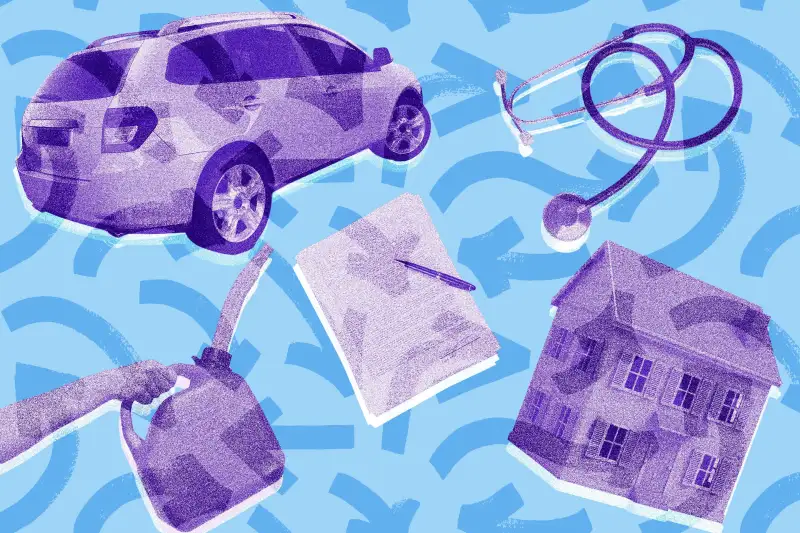Here’s What’s Getting Cheaper (and More Expensive) as Inflation Eases

While Americans are still feeling the effects of inflation, October's pricing data was some of the most encouraging in recent memory.
Costs declined for cars (both new and used), as well as energy and travel, helping consumer prices over remain unchanged from the month before, according to the consumer price index (CPI). Annual inflation fell from 3.7% in September to 3.2% in October.
Data released Tuesday showing cooling inflation was good news for the economy, sending stocks soaring on hopes that the Federal Reserve may be done raising interest rates.
At the same time, however, some things are still getting more expensive, like car insurance and rent. Overall, households are spending $205 more per month for the same goods and services compared to a year ago and $680 more per month compared to 2021, according to Moody’s.
Here are three things that got cheaper in October and three things that are still getting more expensive:
3 things that are getting cheaper
Some of the spending categories that drove inflation over the past few years experienced price declines in October.
New and used cars
Improved vehicle inventory and high auto loan rates are causing car prices to fall. Used car prices were down 0.8% from September to October, the fifth consecutive month of declines.
New car prices fell 0.1% — pretty good considering that the autoworkers’ strike, which ended in late October, was supposed to lead to higher car prices.
According to Kelley Blue Book, the average list price of a used car was $26,533 in October, 3% lower than a year ago. The average transaction price for new cars was $47,936, down 1.4% from October 2022. Prices for new electric vehicles, meanwhile, are down more than 20% in the past year.
Gas and energy
The national average price for a gallon of gas has declined for eight consecutive weeks, according to GasBuddy. At $3.33, the average price is 42.6 cents lower than a year ago.
The downward trend can be attributed to seasonal patterns — less driving in the winter and cheaper fuel blends — as well as a more than 10% decline in oil prices since late September. (Crude oil accounts for about half of what you as a consumer pay for a gallon of gas.)
Overall, the CPI showed a 2.5% month-to-month decline in energy prices, with fuel oil prices declining in addition to gasoline.
Travel
Airfare and hotel prices declined in October. Jeffrey Roach, chief economist for LPL Financial, noted that hotel prices fell 2.9% in the past month "likely on the heels of declining demand for travel," while competition between airlines and lower fuel prices contributed to cheaper plane tickets (-0.9%).
Holiday travel could be a different story, at least for flight prices. According to AAA, domestic flights are averaging $681 in November and December, which is a 5% increase from last year.
3 things that are getting more expensive
Here's what's still getting more expensive:
Car insurance
The CPI report showed that auto insurance prices are up 19.2% in the past year after another 1.9% increase in October.
Bill Adams, chief economist for Comerica Bank, said in a note that car insurance is one key area where "you can still see the momentum built up in inflation flowing through the CPI basket," adding that the increase reflects "the lagged effects of big increases in car prices and repair costs in the last few years."
To combat rising car insurance rates, you can consider raising your deductible in exchange for a lower monthly premium. Alternatively, you can shop around and try to find a cheaper car insurance provider.
Medical care
The cost of medical care services increased by 0.3% in October, and within this category, prices were up for hospital services, dental services and nursing homes. Prices for medical care commodities, including prescription drugs, also increased by 0.4%.
Rent
Housing prices including rents continue to rise, however the pace of increase appears to be moderating. The CPI showed shelter prices were up 0.3% on the month (compared to 0.6% the month before) and up 6.7% on the year. The Bureau of Labor Statistics said in its release that this increase accounts for over 70% of annual inflation in the index that excludes food and energy.
Bank of America reports "the trend in rent inflation remains stickier than we had previously thought," noting that rent prices have risen by 0.5% three months in a row. "While we continue to expect rent inflation to slow given the declines in asking rent inflation, it is proving to be a gradual process," the bank's analysts said in a note.
More from Money:
13 Best Credit Cards of November 2023
College Tuition Prices Are Actually Decreasing Thanks to Inflation
Credit Card Balances Just Grew by the Biggest Amount in Over 20 Years

